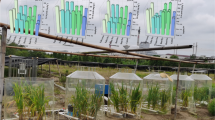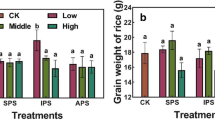Abstract
Purpose
Over-accumulation of cadmium and lead in rice grain is a global concern as it has adverse health impacts. Atmospheric deposition is an important source of heavy metal accumulation in soil, but contribution to crops has not been quantified and the mechanisms of foliar Cd and Pb uptake via the stomata of rice leaves exposed to atmospheric fallout are unclear.
Methods
To quantify the contribution of atmospheric deposition on Cd and Pb accumulation in rice grains, a rice pot experiment with four exposure treatments (T1, all day exposure without geotextile membranes; T2, all day exposure with geotextile membranes; T3, daytime exposure with geotextile membranes; and T4, night exposure with geotextile membranes) using severely (ZZ) and moderately (XT) polluted soils was conducted.
Results
Cd content in shoots and roots was T1 > T2, T3 > T4 in XT soils, and T1 > T2, T4 > T3 in ZZ soils, while Pb content in both soils was T1 > T2, and T4 > T3. Cd and Pb contents in rice grains showed the same trend. Using the isotope ratios tracing method (114/111Cd, 112/111Cd, and 207/206Pb, 208/206Pb), it can be concluded that the contribution of atmospheric deposition to rice grains was quantified as 63.55% and 18.01% for Cd, and 27.69% and 41.13% for Pb in XT and ZZ soils, respectively.
Conclusions
Foliar uptake atmospheric deposition had substantial effect on Cd and Pb accumulation in rice grains and the control of heavy metal foliar uptake should be paid more attention to maintain rice safety production.
Graphical abstract









Similar content being viewed by others
References
Baycu G, Gevrek-Kürüm N, Moustaka J et al (2016) Cadmium-zinc accumulation and photosystem II responses of noccaea caerulescens to Cd and Zn exposure. Environ Sci Pollut Res 24(3):2840–2850
Bermudez GMA, Jasan R, Plá R et al (2012) Heavy metals and trace elements in atmospheric fall-out: Their relationship with topsoil and wheat element composition. J Hazard Mater 213–214:447–456
Bi XY, Feng XB, Yang YG et al (2009) Allocation and source attribution of lead and cadmium in maize (Zea mays L.) impacted by smelting emissions. Environ Pollut 157(3):834–839
Bohdálková L, Novák M, Krachler M et al (2020) Cadmium contents of vertically and horizontally deposited winter precipitation in central Europe: spatial distribution and long-term trends. Environ Pollut 265:114949
Bu Q, Lv T, Shen H et al (2014) Regulation of Drought Tolerance by the F-Box Protein MAX2 in Arabidopsis. Plant Physiol 164(1):424–439. https://doi.org/10.1104/pp.113.226837
Canepari S, Perrino C, Olivieri F et al (2008) Characterisation of the traffic sources of pm through size-segregated sampling, sequential leaching and icp analysis. Atmos Environ 42(35):8161–8175
Cao XY, Tan CY, Wu LH et al (2020) Atmospheric deposition of cadmium in an urbanized region and the effect of simulated wet precipitation on the uptake performance of rice. Sci Total Environ 700:134513
De Temmerman L, Ruttens A, Waegeneers N (2012a) Impact of atmospheric deposition of As, Cd and Pb on their concentration in carrot and celeriac. Environ Pollution 166:187–195
Du Y, Hu XF, Wu XH et al (2013) Affects of mining activities on Cd pollution to the paddy soils and rice grain in Hunan province, Central South China. Environ Monit Assess 185(12):9843–9856
Feng JF, Wang YX, Zhao J et al (2011) Source attributions of heavy metals in rice plant along highway in Eastern China. J Environ Sci 23(7):1158–1164
Feng WL, Guo ZH, Peng C et al (2018) Modelling mass balance of cadmium in paddy soils under long term control scenarios. Environ Science: Processes & Impacts 20:1158–1166
Feng WL, Guo ZH, Xiao XY et al (2019) Atmospheric deposition as a source of cadmium and lead to soil-rice system and associated risk assessment. Ecotoxicol Environ Saf 180:160–167
Fernández V, Eichert T (2009) Uptake of hydrophilic solutes through plant leaves: current state of knowledge and perspectives of foliar fertilization. CRC Crit Rev Plant Sci 28(1–2):36–68
Fernández-Olmo I, Puente M, Montecalvo L et al (2014) Source contribution to the bulk atmospheric deposition of minor and trace elements in a Northern Spanish coastal urban area. Atmos Res 145–146:80–91
Gajbhiye T, Pandey SK, Kim KH et al (2016) Airborne foliar transfer of pm bound heavy metals in cassia siamea: a less common route of heavy metal accumulation. Sci Total Environ 573:123–130
Gao PP, Xue PY, Dong JW et al (2021) Contribution of PM2.5-Pb in atmospheric fallout to Pb accumulation in Chinese cabbage leaves via stomata. J Hazard Mater 407:124356
Gao PP, Zhang XM, Xue PY et al (2022) Mechanism of Pb accumulation in Chinese cabbage leaves: Stomata and trichomes regulate foliar uptake of Pb in atmospheric PM2.5. Environ Pollut 293:118585
Guan QY, Wang FF, Xu CQ et al (2018) Source apportionment of heavy metals in agricultural soil based on PMF: a case study in Hexi Corridor, northwest China. Chemosphere 193:189–197
Hou QY, Yang ZF, Ji JF et al (2014) Annual net input fluxes of heavy metals of the agro-ecosystem in the Yangtze River delta, China. J Geochemical Explor 139:68–84
Hu X, Zhang Y, Luo J et al (2011) Accumulation and quantitative estimates of airborne lead for a wild plant (Aster subulatus). Chemosphere 82(10):1351–1357
Huang Y, Deng MH, Wu SF et al (2018) A modified receptor model for source apportionment of heavy metal pollution in soil. J Hazard Mater 354:161–169
Huang Y, Li TQ, Wu CX et al (2015) An integrated approach to assess heavy metal source apportionment in peri-urban agricultural soils. J Hazard Mater 299:540–549
Lei HL, Cong WY, Cai ZL et al (2021) The key processes and influencing factors of selenium absorption by plant roots and leaves. J Plant Nutr Fertilizers 155(08):1456–1467 ((in Chinese))
Li H, Luo N, Yan WL et al (2017) Cadmium in rice: Transport mechanisms, influencing factors, and minimizing measures. Environ Pollut 224:622–630
Jaeckels JM, Bae MS, Schauer JJ (2007) Positive matrix factorization (PMF) analysis of molecular marker measurements to quantify the sources of organic aerosols. Environ Sci Technol 41(16):5763–5769
Kaier H (2015) Stomatal uptake of mineral particles from a sprayed suspension containing an organosilicone surfactant. J Plant Nutr Soil Sci 177(6):869–874
Keller C, Rizwan BM, Davidian C et al (2014) Effect of silicon on wheat seedlings (Triticum turgidum L.) grown in hydroponics and exposed to 0 to 30 µm Cu. Planta 241(4):847–860
Lee PK, Choi BY, Kang MJ (2015) Assessment of mobility and bio-availability of heavy metals in dry depositions of Asian dust and implications for environmental risk. Chemosphere 119:1411–1421
Li F, Huang JH, Zeng GM et al (2013) Spatial risk assessment and sources identification of heavy metals in surface sediments from Dongting Lake, Middle China. J Geochem Explor 132:75–83
Liu HL, Zhou J, Li M et al (2019a) Study of the bioavailability of heavy metals from atmospheric deposition on the soil-pakchoi (Brassica chinensis L.) system. J Hazard Mater 362:9–12
Liu J, Wang DQ, Song B et al (2019b) Source apportionment of Pb in a rice-soil system using field monitoring and isotope composition analysis. J Geochem Explor 204:83–89
Liu ZP, Zhang QF, Han TQ et al (2016) Heavy Metal Pollution in a Soil-Rice System in the Yangtze River Region of China. Int J Environ Res Public Health 13(1):1–16
Louie PKK, Watson JG, Chow JC et al (2005) Seasonal characteristics and regional transport of PM2.5 in Hong Kong. Atmos Environ 39(9):1695–1710
Luo L, Ma YB, Zhang SZ et al (2009) An inventory of trace element inputs to agricultural soils in China. J Environ Manage 90:2524–2530
Majer P, Hideg éva (2012) Existing antioxidant levels are more important in acclimation to supplemental UV-B irradiation than inducible ones: Studies with high light pretreated tobacco leaves. Emirates J Food Agric 24(6):598–606
Mansfield TA, Majernik O (1970) Can stomata play a part in protecting plants against air pollutants?. Environ Pollut 1(2):149–154. https://doi.org/10.1016/0013-9327(70)90015-7
Mekonnen DW, Flügge UI, Ludewig F (2016) Gamma-aminobutyric acid depletion affects stomata closure and drought tolerance of Arabidopsis thaliana. Plant Sci 245:25–34
Melotto M, Zhang L, Oblessuc PR et al (2017) Stomatal defense a decade later. Plant Physiol 174:561–571
Sawidis T, Krystallidis P, Veros D et al (2012) A study of air pollution with heavy metals in Athens city and Attica basin using evergreen trees as biological indicators. Biol Trace Elem Res 148:396–408
Schreck E, Dappe V, Sarret G et al (2014) Foliar or root exposures to smelter particles: Consequences for lead compartmentalization and speciation in plant leaves. Sci Total Environ 476–477:667–676
Schreck E, Foucault Y, Geret F et al (2011) Influence of soil ageing on bioavailability and ecotoxicity of lead carried by process waste metallic ultrafine particles. Chemosphere, 85 – 10, pp 1555–1562
Schreck E, Foucault Y, Sarret G et al (2012) Metal and metalloid foliar uptake by various plant species exposed to atmospheric industrial fallout: Mechanisms involved for lead. Sci Total Environ 427–428:253–262
Shahid M, Dumat C, Khalid S et al (2017) Foliar heavy metal uptake, toxicity and detoxification in plants: a comparison of foliar and root metal uptake. J Hazard Mater 325:36–58
Sharma RK, Agrawal M, Marshall FM (2008) Heavy metal (Cu, Zn, Cd and Pb) contamination of vegetables in urban india: a case study in varanasi. Environ Pollut 154(2):254–263
Tang WZ, Shan BQ, Zhang H et al (2010) Heavy metal sources and associated risk in response to agricultural intensification in the estuarine sediments of Chaohu Lake Valley, East China. J Hazard Mater 176(1–3):945–951
Temmerman LD, Ruttens A, Waegeneers N (2012) Impact of atmospheric deposition of As, Cd and Pb on their concentration in carrot and celeriac. Environ Pollut 166:187–195
Tian HZ, Zhu CY, Gao JJ et al (2015) Quantitative assessment of atmospheric emissions of toxic heavy metals from anthropogenic sources in china: historical trend, spatial distribution, uncertainties, and control policies. Atmos Chem Phys 15(8):12107–12166
Tomasevic M, Anicic M (2010) Trace element content in urban tree leaves and SEM-EDAX characterization of deposited particles. FU Phys Chem Technol 8:1–13
Uzu G, Sobanska S, Sarret G et al (2010) Foliar Lead Uptake by Lettuce Exposed to Atmospheric Fallouts. Environ Sci Technol 44(3):1036–1042. https://doi.org/10.1021/es902190u
Wong CSC, Li XD (2004) Pb contamination and isotopic composition of urban soils in Hong Kong. Sci Total Environ 319(1–3):185–195
Xiong DL, Douthe C, Flexas J (2018) Differential coordination of stomatal conductance, mesophyll conductance, and leaf hydraulic conductance in response to changing light across species. Plant Cell Environ 41:436–450
Yin J, Harrison R, Chen Q et al (2010) Source apportionment of fine particles at urban background and rural sites in the UK atmosphere. Atmos Environ 44(6):841–851
Zhang YL, Zhang SX, Zhu FP et al (2018) Atmospheric heavy metal deposition in agro-ecosystems in China. Environ Sci Pollut Res 25:5822–5831
Zhou J, Du BY, Liu HL et al (2020) The bioavailability and contribution of the newly deposited heavy metals (copper and lead) from atmosphere to rice (oryza sativa L.). J Hazard Mater 384:121285
Acknowledgements
We gratefully acknowledge the financial support of the National Natural Science Foundation of China (NSFC) (No.42007143), Natural Science Foundation of Hunan Province, China (No. 2020JJ5224), Scientific Research Fund of Hunan Provincial Education Department, China (No.19B250), and the Science Foundation for Young Scholars of Hunan Agricultural University (No.19QN37).
Author information
Authors and Affiliations
Corresponding authors
Ethics declarations
Conflict of interest
The authors declare that they have no conflict of interest. This manuscript has not been published or presented elsewhere in part or in entirety and is not under consideration by another journal. We have read and understood your journal’s policies, and we believe that neither the manuscript nor the study violates any of these. There are no conflicts of interest to declare.
Additional information
Responsible Editor: Jian Feng Ma.
Publisher’s note
Springer Nature remains neutral with regard to jurisdictional claims in published maps and institutional affiliations.
Supplementary Information
Below is the link to the electronic supplementary material.
ESM 1
(DOCX 201 KB)
Rights and permissions
About this article
Cite this article
Zhu, Z., Xu, Z., Peng, J. et al. The contribution of atmospheric deposition of cadmium and lead to their accumulation in rice grains. Plant Soil 477, 373–387 (2022). https://doi.org/10.1007/s11104-022-05429-x
Received:
Accepted:
Published:
Issue Date:
DOI: https://doi.org/10.1007/s11104-022-05429-x




